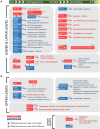Transcriptional Reprogramming of Pea Leaves at Early Reproductive Stages
- PMID: 31440268
- PMCID: PMC6693388
- DOI: 10.3389/fpls.2019.01014
Transcriptional Reprogramming of Pea Leaves at Early Reproductive Stages
Abstract
Pea (Pisum sativum L.) is an important source of dietary proteins. Nutrient recycling from leaves contributes to the accumulation of seed proteins and is a pivotal determinant of protein yields in this grain legume. The aim of this study was to unveil the transcriptional regulations occurring in pea leaves before the sharp decrease in chlorophyll breakdown. As a prelude to this study, a time-series analysis of 15N translocation at the whole plant level was performed, which indicated that nitrogen recycling among organs was highly dynamic during this period and varied depending on nitrate availability. Leaves collected on vegetative and reproductive nodes were further analyzed by transcriptomics. The data revealed extensive transcriptome changes in leaves of reproductive nodes during early seed development (from flowering to 14 days after flowering), including an up-regulation of genes encoding transporters, and particularly of sulfate that might sustain sulfur metabolism in leaves of the reproductive part. This developmental period was also characterized by a down-regulation of cell wall-associated genes in leaves of both reproductive and vegetative nodes, reflecting a shift in cell wall structure. Later on, 27 days after flowering, genes potentially switching the metabolism of leaves toward senescence were pinpointed, some of which are related to ribosomal RNA processing, autophagy, or transport systems. Transcription factors differentially regulated in leaves between stages were identified and a gene co-expression network pointed out some of them as potential regulators of the above-mentioned biological processes. The same approach was conducted in Medicago truncatula to identify shared regulations with this wild legume species. Altogether the results give a global view of transcriptional events in leaves of legumes at early reproductive stages and provide a valuable resource of candidate genes that could be targeted by reverse genetics to improve nutrient remobilization and/or delay catabolic processes leading to senescence.
Keywords: co-expression; leaves; legumes; nitrogen remobilization; reproductive period; transcription factors; transcriptomics; transporters.
Figures






Similar articles
-
Legume adaptation to sulfur deficiency revealed by comparing nutrient allocation and seed traits in Medicago truncatula.Plant J. 2013 Dec;76(6):982-96. doi: 10.1111/tpj.12350. Epub 2013 Nov 12. Plant J. 2013. PMID: 24118112
-
A molecular and structural characterization of senescing Arabidopsis siliques and comparison of transcriptional profiles with senescing petals and leaves.Plant J. 2009 Feb;57(4):690-705. doi: 10.1111/j.1365-313X.2008.03722.x. Epub 2008 Oct 16. Plant J. 2009. PMID: 18980641
-
Genome-wide transcriptional responses to water deficit during seed development in Pisum sativum, focusing on sugar transport and metabolism.Physiol Plant. 2023 Nov-Dec;175(6):e14062. doi: 10.1111/ppl.14062. Physiol Plant. 2023. PMID: 38148238
-
Nitrogen remobilization during leaf senescence: lessons from Arabidopsis to crops.J Exp Bot. 2017 May 1;68(10):2513-2529. doi: 10.1093/jxb/erw365. J Exp Bot. 2017. PMID: 27707774 Review.
-
Functional Genomics and Genetic Control of Compound Leaf Development in Medicago truncatula: An Overview.Methods Mol Biol. 2018;1822:197-203. doi: 10.1007/978-1-4939-8633-0_14. Methods Mol Biol. 2018. PMID: 30043306 Review.
Cited by
-
Pisum sativum Response to Nitrate as Affected by Rhizobium leguminosarum-Derived Signals.Plants (Basel). 2022 Jul 28;11(15):1966. doi: 10.3390/plants11151966. Plants (Basel). 2022. PMID: 35956443 Free PMC article.
References
-
- Aharoni A., Dixit S., Jetter R., Thoenes E., van Arkel G., Pereira A. (2004). The SHINE clade of AP2 domain transcription factors activates wax biosynthesis, alters cuticle properties, and confers drought tolerance when overexpressed in arabidopsis. Plant Cell 16, 2463–2480. 10.1105/tpc.104.022897 - DOI - PMC - PubMed
-
- Alves-Carvalho S., Aubert G., Carrère S., Cruaud C., Brochot A. L., Jacquin F., et al. . (2015). Full-length de novo assembly of RNA-seq data in pea (Pisum sativum L.) provides a gene expression atlas and gives insights into root nodulation in this species. Plant J. 84, 1–19. 10.1111/tpj.12967 - DOI - PubMed
LinkOut - more resources
Full Text Sources
Molecular Biology Databases
Research Materials

